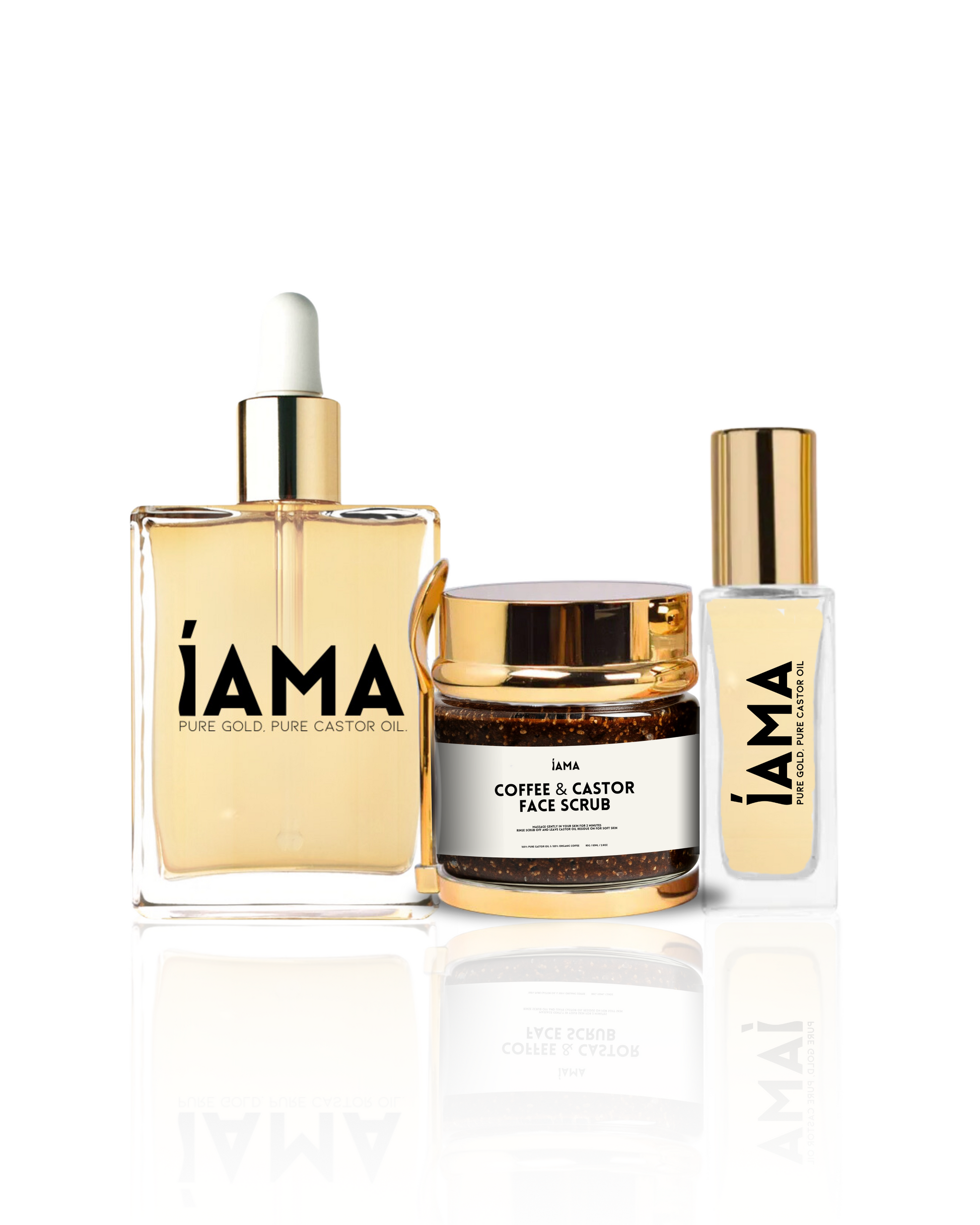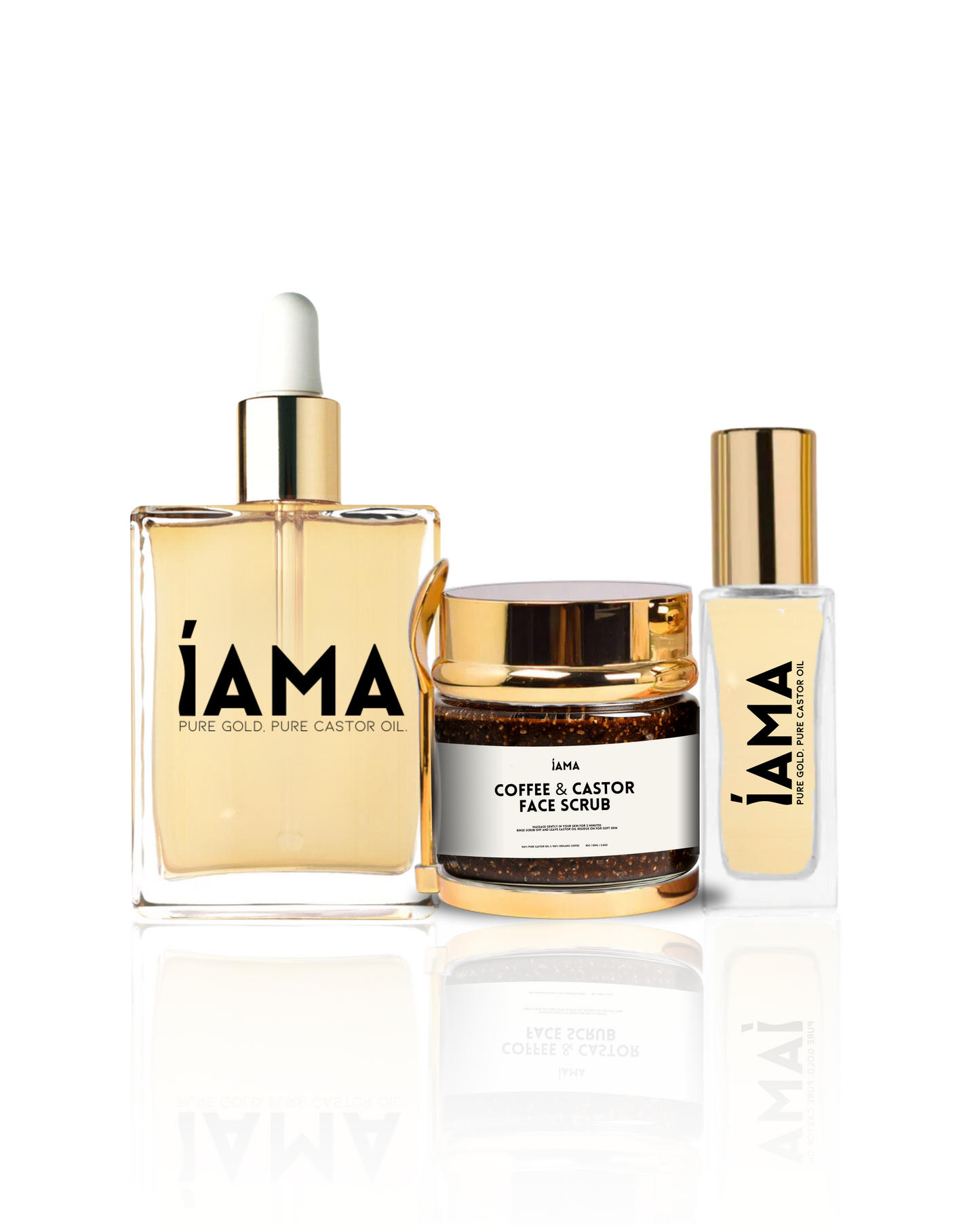Imagine your body as a finely tuned orchestra, with hormones as the skilled musicians and your uterus as the grand concert hall. Once a month, this orchestra performs a complex symphony known as the menstrual cycle. But for many women, this performance comes with an unwelcome accompaniment: the sharp, sometimes debilitating pain of menstrual cramps.
These cramps, also known as dysmenorrhea, can range from a mild nuisance to a show-stopping spectacle that disrupts daily life.
Did you know that your womb has special receptors that interact with the unique miracle molecule found in castor oil?
When this happens, it increases blood circulation to your womb, nourishes the tissues, reduces inflammation pathways that cause those painful cramps and also harmonises your womb contractions to facilitate menstrual flow.
So if you're suffering with painful periods and you're thinking of using castor oil, keep reading!
Facts About Painful Menstrual Cramps:

-
Medical term: The medical term for painful periods is dysmenorrhea.
-
Prevalence: Up to 90% of women experience some degree of menstrual pain.
-
Types: There are two types of dysmenorrhea - primary (occurs naturally) and secondary (caused by an underlying condition).
-
Age factor: Painful periods often start within the first few years after menarche (first menstruation).
-
Prostaglandins: These hormone-like substances are the primary cause of menstrual cramps.
-
Associated symptoms: Nausea, vomiting, diarrhea, and headaches can accompany menstrual cramps.
-
Severity: Pain can range from mild discomfort to severe, incapacitating pain.
-
Duration: Cramps typically last 24-72 hours, peaking within the first few days of menstruation.
-
Risk factors: Smoking, early onset of menstruation, and family history can increase the likelihood of painful periods.
-
Treatment options: Nervous system healing, womb healing and lifestyle changes can help with menstrual pain.
-
Impact: Severe menstrual pain can affect quality of life, work productivity, and school attendance.
-
Underlying conditions: Endometriosis, fibroids, and pelvic inflammatory disease can cause secondary dysmenorrhea.
-
Exercise: Regular physical activity may help reduce the severity of menstrual cramps.
-
Nutrition: Some studies suggest that certain dietary changes may help alleviate menstrual pain by reducing inflammation.
-
Cultural factors: Perception and management of menstrual pain can vary across cultures.
What Causes Painful Menstrual Cramps?

There's a number of reasons why you might experience execssive menstrual cramps and also painful periods.
Prostaglandin Imbalance: During your menstrual cycle, your uterus produces prostaglandins - these hormones help regulate your contractions. An overproduction can cause the uterine muscles to contract too strongly, leading to cramping that can range from uncomfortable for a few hours to debilitating for many days.
Inflammation: Inflammation in the uterus and surrounding pelvic area can significantly amplify your menstrual cramps. Inflammatory compounds sensitize your nerve endings and can cause the uterine muscles to spasm.
Uterine Fibroids: Fibroids or adenomyosis, can distort the uterine shape and put pressure on the surrounding tissues, triggering painful cramps.
Endometriosis: This condition occurs when the endometrial tissue that normally lines the inside of the uterus grows outside of the uterus on other organs. Displaced tissue can bleed and become inflamed during the menstrual cycle, causing severe pelvic pain.
Cervical Stenosis: A narrowing or block of your cervical opening can prevent the free flow of menstrual blood, resulting in painful uterine contractions as the body tries to expel the blood.
Stress, Trauma and Nervous System Dysregulation: High stress levels and unresolved trauma held in the nervous system and womb can disrupt the delicate balance needed for smooth, pain-free periods.
How Can Castor Oil Help Your Painful Periods?
Castor oil's secret weapon for relieving painful periods is a naturally occurring fatty acid called ricinoleic acid which has a unique ability to bind to the EP3 receptors located within the lining of the uterus.
These EP receptors play a crucial role in regulating the uterine response to fluctuating reproductive hormones like estrogen and progesterone.
By interacting with EP3 receptors, ricinoleic acid can trigger a cascade of beneficial effects that help alleviate menstrual cramps and discomfort:
- Stimulates coordinated uterine contractions
- Facilitates shedding of the uterine lining during menstruation
- Down regulates inflammatory pathways that contribute to painful periods
- Enhances blood flow to your uterus which nourishes reproductive tissues
The ricinoleic acid is able to "communicate" with your body on a cellular level, restoring hormonal balance and relieving uterine distress. This makes castor oil a powerful natural ally for finding relief from debilitating menstrual symptoms.
Understanding the Role of Prostaglandin E (EP) Receptors in Uterine Function and Menstrual Health
The EP receptors act as an intermediary, translating hormonal signals into the appropriate physiological responses within the uterus. This is crucial for maintaining a regular and pain free menstrual cycle.
Prostaglandin E (EP) receptors in our womb play a crucial role including:
Uterine Contractions: The EP receptors, particularly the EP3 subtype, are involved in mediating the contractions of the uterine smooth muscle. When activated, these receptors trigger signaling cascades that lead to the contraction of the uterine wall. This is important for facilitating menstrual flow and even inducing labor when necessary.
Inflammation Regulation: The EP receptors also help modulate inflammatory pathways within the uterus. Certain prostaglandins that bind to these receptors can have anti-inflammatory effects, helping to reduce uterine irritation and pain associated with conditions like dysmenorrhea (painful periods).
Blood Flow Regulation: Prostaglandin signaling through the EP receptors can influence uterine blood flow. This helps ensure proper oxygenation and nourishment of the uterine lining during the menstrual cycle and pregnancy.
Hormone Sensitivity: The EP receptors interact with hormones like estrogen and progesterone, which are crucial for regulating the uterine cycle and preparing the uterus for implantation during pregnancy. This hormonal interplay helps maintain reproductive health.
Tissue Remodeling: Activation of the EP receptors can trigger changes in the uterine tissue structure, such as the shedding of the endometrial lining during menstruation. This cyclical remodeling is essential for the health and function of the uterus.
How Castor Oil Interacts with Uterine Receptors to Alleviate Menstrual Cramps and Pain

When ricinoleic acid, binds to these EP3 receptors, it sets off a cascade of beneficial effects. It can help stimulate coordinated uterine contractions to facilitate menstrual flow, reduce inflammatory pathways that contribute to painful cramps, and enhance blood circulation to nourish the reproductive tissues.
In essence, castor oil's active compounds are communicating with your body on a cellular level, helping to restore harmony, ease discomfort, and support overall uterine health.
In other words, castor oil's active compounds are essentially "communicating" with your womb on a cellular level to restore harmony, ease discomfort, and support your overall reproductive wellness.
But the benefits of castor oil don't stop there. Its anti-inflammatory properties can also soothe other menstrual woes, like breast tenderness and mood swings.
5 Ways To Use Castor Oil for Menstrual Cramps

Here are 5 different ways to use castor oil for relief.
Castor Oil Packs: One of the most popular methods involves creating a castor oil pack. Soak a piece of flannel or cotton cloth in warm castor oil, then place it on your lower abdomen. Cover it with plastic wrap and apply a heating pad or hot water bottle on top for about 30-60 minutes. The heat helps the oil penetrate the skin, potentially reducing inflammation and easing cramps.
Massage Oil: Use it for a gentle abdominal massage. Massage the oil into your womb circular motions. This can promote relaxation and improve blood circulation, which may help alleviate pain. Click here to read more about the benefits of using Castor Oil in your belly button.
Warm Castor Oil Bath: Add a few tablespoons of IAMA castor oil to a warm bath. Soaking in the bath can help relax your muscles and provide soothing relief from menstrual cramps. The warmth combined with the oil can enhance relaxation and comfort.
Castor Oil Infused Tea: While not a direct application, you can create a soothing tea by infusing castor oil with herbal teas known for their anti-inflammatory properties, such as ginger or chamomile. A small amount of castor oil (1tsp)can be added to the tea to potentially help with cramps from the inside out.
Topical Application: Simply applying a small amount of warm castor oil directly to the lower abdomen and lower back can provide relief. You can gently massage the oil into the skin, allowing it to absorb overnight. This method can be combined with a heating pad for enhanced effects.
Our Top 3 Essential Oils to Blend with Castor Oil for Effective Relief from Menstrual Cramps

Here are the top three essential oils to blend with castor oil for relieving menstrual cramps and pain, along with explanations of how they work:
- Lavender oil is renowned for its calming and anti-inflammatory properties. It helps relax the muscles and reduce tension, which can alleviate the discomfort associated with menstrual cramps. Its soothing aroma also promotes relaxation and can help reduce anxiety, making it easier to cope with pain.
- Peppermint oil contains menthol, which has a cooling effect and can help relieve pain and discomfort. Its analgesic properties can reduce muscle spasms and enhance blood circulation, providing relief from cramps. Additionally, the invigorating scent can help improve mood and reduce feelings of fatigue often associated with menstruation.
- Clary sage oil is known for its hormone-balancing effects and can help reduce the severity of menstrual cramps. It has anti-inflammatory properties that can ease pain and discomfort. Clary sage is also thought to promote relaxation and reduce stress, which can be beneficial during menstruation.
How to Use the Blends:
Blend Preparation: Mix a few drops of your chosen essential oil (typically 3-5 drops) with a tablespoon of castor oil.
Application: Gently massage the blend onto your lower abdomen in circular motions. You can also apply a warm compress over the area for enhanced relief.
Safety Note: Always perform a patch test to check for allergic reactions before using essential oils on your skin, and consult with a healthcare professional if you are pregnant or have underlying health conditions.
By combining these essential oils with castor oil, you can create a soothing blend that may help alleviate menstrual cramps and promote overall comfort during your period.
Read our blog post on using Castor Oil in your belly button here and womb health here
iAMA is the home of pure gold, pure Castor Oil.
♥︎ Shop Castor Oil gold www.iamawellness.com
♥︎ Contact us by emailing contact@iamawellness.com
♥︎ Follow us on Instagram @iamawellness






